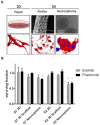Glioblastoma's Next Top Model: Novel Culture Systems for Brain Cancer Radiotherapy Research
- PMID: 30621226
- PMCID: PMC6356812
- DOI: 10.3390/cancers11010044
Glioblastoma's Next Top Model: Novel Culture Systems for Brain Cancer Radiotherapy Research
Abstract
Glioblastoma (GBM), the most common and aggressive primary brain tumor in adults, remains one of the least treatable cancers. Current standard of care-combining surgical resection, radiation, and alkylating chemotherapy-results in a median survival of only 15 months. Despite decades of investment and research into the development of new therapies, most candidate anti-glioma compounds fail to translate into effective treatments in clinical trials. One key issue underlying this failure of therapies that work in pre-clinical models to generate meaningful improvement in human patients is the profound mismatch between drug discovery systems-cell cultures and mouse models-and the actual tumors they are supposed to imitate. Indeed, current strategies that evaluate the effects of novel treatments on GBM cells in vitro fail to account for a wide range of factors known to influence tumor growth. These include secreted factors, the brain's unique extracellular matrix, circulatory structures, the presence of non-tumor brain cells, and nutrient sources available for tumor metabolism. While mouse models provide a more realistic testing ground for potential therapies, they still fail to account for the full complexity of tumor-microenvironment interactions, as well as the role of the immune system. Based on the limitations of current models, researchers have begun to develop and implement novel culture systems that better recapitulate the complex reality of brain tumors growing in situ. A rise in the use of patient derived cells, creative combinations of added growth factors and supplements, may provide a more effective proving ground for the development of novel therapies. This review will summarize and analyze these exciting developments in 3D culturing systems. Special attention will be paid to how they enhance the design and identification of compounds that increase the efficacy of radiotherapy, a bedrock of GBM treatment.
Keywords: 3D culture systems; glioblastoma; glioma; pre-clinical drug development; radiotherapy.
Conflict of interest statement
The authors declare no conflict of interest.
Figures


References
-
- Verhaak R.G., Hoadley K.A., Purdom E., Wang V., Qi Y., Wilkerson M.D., Miller C.R., Ding L., Golub T., Mesirov J.P., et al. Integrated genomic analysis identifies clinically relevant subtypes of glioblastoma characterized by abnormalities in PDGFRA, IDH1, EGFR, and NF1. Cancer Cell. 2010;17:98–110. doi: 10.1016/j.ccr.2009.12.020. - DOI - PMC - PubMed
Publication types
Grants and funding
LinkOut - more resources
Full Text Sources
Other Literature Sources

